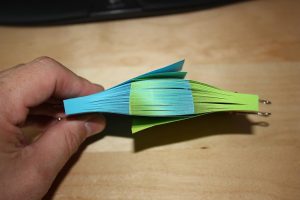How and Why Does Interleaving Work?
A common dilemma for many college students is how best to study the material to pass a course. One strategy, interleaving, is one of the most effective strategies for retaining material. Interleaving, also known as mixed practice, “involves mixing together different topics or forms of practice, in order to facilitate learning” (Effectiviology, 2022, para.1). Interleaving contrasts with a more familiar practice of blocked learning, which involves studying one concept at a time before moving to the next; however, students are not as versed or likely to implement interleaving unless the instructor models it first in the context of a course (Whitman & Kelleher, 2021).
In “A Conversation with Pooja Agarwal on Interleaving” (2018), Agarwal uses two analogies to describe interleaving:
- First, interleaving is like a fruit salad containing bits of different items that have something in common. The ingredients of the salad are all fruits, but the fruits are not all the same. You would not add a vegetable, such as broccoli, to the fruit salad. Likewise, with interleaving, the skills and concepts connect in some way.
- Second, interleaving is like a baseball player in batting practice. If the batter received the same type of ball each time, they would know what to expect and can prepare for it; however, interleaving would involve mixing up the types of balls (fastball, curve ball, change up, etc.) so the batter has to stay alert and adapt for different possibilities.
How and Why Does Interleaving Work?
According to Ferlazzo (2021), the practice of interleaving has been widely studied in different disciplines, including math, athletics, and music. In “The What Why and How of Interleaving” Ferlazzo (2021) explains interleaving works because it “trains the brain to traverse between concepts by creating different practices rather than relying on rote response or muscle memory” (para. 8). When this happens, it forces the brain to distinguish concepts and activates different problem-solving techniques.
Strenger (2016) offers four helpful tips to practice interleaving:
- The skills and concepts you mix during interleaving should have some similarities.
- Mix new material with previously covered material.
- Combine interleaving with other learning strategies.
- If you do not see results immediately after practicing interleaving, do not worry. Just keep practicing!
Nguyen (2021) offers these additional strategies for practicing interleaving with students:
- Reduce the number of practice problems on an assignment to balance the complexity of interleaving.
- Offer students practice with different problems and activities by rotating them through learning stations.
- Plan integrated projects for students to apply the interleaved skills and concepts.
- Cult of Pedagogy devotes several resources to the topic of interleaving, including blog entries, podcast episodes, and tips.
- Check out Retrieval Practice.org to learn more tips and to download a guide to interleaving.
- Watch this video to hear students and instructors from the University of Arizona discuss their experiences with interleaving.
A conversation with Pooja Agarwal on Interleaving. (2018, August 10). The Learning Agency. YouTube Video. https://www.youtube.com/watch?v=bZE0gC5B0aA.
Ferlazzo, L. (2021, May 30). The what, why and how of interleaving. Education Week. https://www.edweek.org/teaching-learning/opinion-the-what-why-how-of-interleaving/2021/05
Interleaving: How Mixed Practice Can Boost Learning. (2022). Effectiviology. https://effectiviology.com/interleaving/
Nguyen, H. (2021, June 11). How to use interleaving to foster deeper learning. Edutopia. https://www.edutopia.org/article/how-use-interleaving-foster-deeper-learning
Strenger, M. (2016, September 9). Interleaved practice: Four ways to learn better by mixing it up. InformEd. https://www.opencolleges.edu.au/informed/learning-strategies/interleaved-practice-4-ways-to-learn-better-by-mixing-it-up/
Whitman, G. & Keller, I. (2021, March 11). Interleaving: One strategy to recover lost learning. Blog. The Center for Transformative Teaching and Learning. https://www.thecttl.org/2021/03/11/interleaving/

 What is Interleaving?
What is Interleaving?